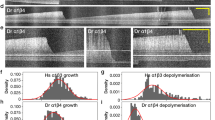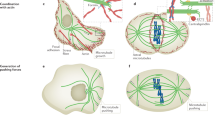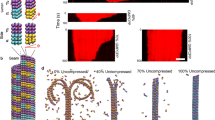Abstract
Microtubules are polymers of tubulin dimers, and conformational transitions in the microtubule lattice drive microtubule dynamic instability and affect various aspects of microtubule function. The exact nature of these transitions and their modulation by anticancer drugs such as Taxol and epothilone, which can stabilize microtubules but also perturb their growth, are poorly understood. Here, we directly visualize the action of fluorescent Taxol and epothilone derivatives and show that microtubules can transition to a state that triggers cooperative drug binding to form regions with altered lattice conformation. Such regions emerge at growing microtubule ends that are in a pre-catastrophe state, and inhibit microtubule growth and shortening. Electron microscopy and in vitro dynamics data indicate that taxane accumulation zones represent incomplete tubes that can persist, incorporate tubulin dimers and repeatedly induce microtubule rescues. Thus, taxanes modulate the material properties of microtubules by converting destabilized growing microtubule ends into regions resistant to depolymerization.
This is a preview of subscription content, access via your institution
Access options
Access Nature and 54 other Nature Portfolio journals
Get Nature+, our best-value online-access subscription
$29.99 / 30 days
cancel any time
Subscribe to this journal
Receive 12 print issues and online access
$259.00 per year
only $21.58 per issue
Buy this article
- Purchase on Springer Link
- Instant access to full article PDF
Prices may be subject to local taxes which are calculated during checkout






Similar content being viewed by others
Data availability
All data that support the conclusions are available from the authors on request, and/or also available in the Supplementary Information.
Code availability
All MATLAB and Mathematica notebooks used for computations, together with the raw data, are available online at https://doi.org/10.6084/m9.figshare.7520033 and https://github.com/RuddiRodriguez/Analysis-of-MT-plus-end-fluctuations.
References
Desai, A. & Mitchison, T. J. Microtubule polymerization dynamics. Annu. Rev. Cell Dev. Biol. 13, 83–117 (1997).
Cross, R. A. Microtubule lattice plasticity. Curr. Opin. Cell Biol. 56, 88–93 (2018).
Kueh, H. Y. & Mitchison, T. J. Structural plasticity in actin and tubulin polymer dynamics. Science 325, 960–963 (2009).
Brouhard, G. J. & Rice, L. M. Microtubule dynamics: an interplay of biochemistry and mechanics. Nat. Rev. Mol. Cell Biol. 19, 451–463 (2018).
Dumontet, C. & Jordan, M. A. Microtubule-binding agents: a dynamic field of cancer therapeutics. Nat. Rev. Drug Discov. 9, 790–803 (2010).
Yang, C. H. & Horwitz, S. B. Taxol((R)): the first microtubule stabilizing agent. Int. J. Mol. Sci. 18, E1733 (2017).
Steinmetz, M. O. & Prota, A. E. Microtubule-targeting agents: strategies to hijack the cytoskeleton. Trends Cell Biol. 28, 776–792 (2018).
Nogales, E. & Kellogg, E. H. Challenges and opportunities in the high-resolution cryo-EM visualization of microtubules and their binding partners. Curr. Opin. Struct. Biol. 46, 65–70 (2017).
Elie-Caille, C. et al. Straight GDP-tubulin protofilaments form in the presence of taxol. Curr. Biol. 17, 1765–1770 (2007).
Alushin, G. M. et al. High-resolution microtubule structures reveal the structural transitions in alphabeta-tubulin upon GTP hydrolysis. Cell 157, 1117–1129 (2014).
Zhang, R., Alushin, G. M., Brown, A. & Nogales, E. Mechanistic origin of microtubule dynamic instability and its modulation by EB proteins. Cell 162, 849–859 (2015).
Kellogg, E. H. et al. Near-atomic model of microtubule–tau interactions. Science 360, 1242–1246 (2018).
Prota, A. E. et al. Molecular mechanism of action of microtubule-stabilizing anticancer agents. Science 339, 587–590 (2013).
Prota, A. E. et al. Structural basis of microtubule stabilization by discodermolide. Chembiochem 18, 905–909 (2017).
Wang, Y. et al. Mechanism of microtubule stabilization by taccalonolide AJ. Nat. Commun. 8, 15787 (2017).
Manka, S. W. & Moores, C. A. The role of tubulin-tubulin lattice contacts in the mechanism of microtubule dynamic instability. Nat. Struct. Mol. Biol. 25, 607–615 (2018).
Brown, T. et al. A phase I trial of taxol given by a 6-hour intravenous infusion. J. Clin. Oncol. 9, 1261–1267 (1991).
Weaver, B. A. How Taxol/paclitaxel kills cancer cells. Mol. Biol. Cell 25, 2677–2681 (2014).
Gianni, L. et al. Nonlinear pharmacokinetics and metabolism of paclitaxel and its pharmacokinetic/pharmacodynamic relationships in humans. J. Clin. Oncol. 13, 180–190 (1995).
Spratlin, J. & Sawyer, M. B. Pharmacogenetics of paclitaxel metabolism. Crit. Rev. Oncol. Hematol. 61, 222–229 (2007).
Mohan, R. et al. End-binding proteins sensitize microtubules to the action of microtubule-targeting agents. Proc. Natl Acad. Sci. USA 110, 8900–8905 (2013).
Bouchet, B. P. et al. Mesenchymal cell invasion requires cooperative regulation of persistent microtubule growth by SLAIN2 and CLASP1. Dev. Cell 39, 708–723 (2016).
Photiou, A., Shah, P., Leong, L. K., Moss, J. & Retsas, S. In vitro synergy of paclitaxel (Taxol) and vinorelbine (navelbine) against human melanoma cell lines. Eur. J. Cancer 33, 463–470 (1997).
Diaz, J. F., Strobe, R., Engelborghs, Y., Souto, A. A. & Andreu, J. M. Molecular recognition of Taxol by microtubules. Kinetics and thermodynamics of binding of fluorescent taxol derivatives to an exposed site. J. Biol. Chem. 275, 26265–26276 (2000).
Li, X., Barasoain, I., Matesanz, R., Diaz, J. F. & Fang, W. S. Synthesis and biological activities of high affinity taxane-based fluorescent probes. Bioorg. Med. Chem. Lett. 19, 751–754 (2009).
Bieling, P. et al. Reconstitution of a microtubule plus-end tracking system in vitro. Nature 450, 1100–1105 (2007).
Akhmanova, A. & Steinmetz, M. O. Control of microtubule organization and dynamics: two ends in the limelight. Nat. Rev. Mol. Cell Biol. 16, 711–726 (2015).
Duellberg, C., Cade, N. I., Holmes, D. & Surrey, T. The size of the EB cap determines instantaneous microtubule stability. eLife 5, e13470 (2016).
Montenegro Gouveia, S. et al. In vitro reconstitution of the functional interplay between MCAK and EB3 at microtubule plus ends. Curr. Biol. 20, 1717–1722 (2010).
Gigant, B. et al. Structural basis for the regulation of tubulin by vinblastine. Nature 435, 519–522 (2005).
Friel, C. T. & Welburn, J. P. Parts list for a microtubule depolymerising kinesin. Biochem. Soc. Trans. 46, 1665–1672 (2018).
Diaz, J. F., Barasoain, I. & Andreu, J. M. Fast kinetics of Taxol binding to microtubules. Effects of solution variables and microtubule-associated proteins. J. Biol. Chem. 278, 8407–8419 (2003).
Zhang, R., LaFrance, B. & Nogales, E. Separating the effects of nucleotide and EB binding on microtubule structure. Proc. Natl Acad. Sci. USA 115, E6191–E6200 (2018).
Kellogg, E. H. et al. Insights into the distinct mechanisms of action of taxane and non-taxane microtubule stabilizers from cryo-EM structures. J. Mol. Biol. 429, 633–646 (2017).
Mitra, A. & Sept, D. Taxol allosterically alters the dynamics of the tubulin dimer and increases the flexibility of microtubules. Biophys. J. 95, 3252–3258 (2008).
Kikumoto, M., Kurachi, M., Tosa, V. & Tashiro, H. Flexural rigidity of individual microtubules measured by a buckling force with optical traps. Biophys. J. 90, 1687–1696 (2006).
Atherton, J. et al. A structural model for microtubule minus-end recognition and protection by CAMSAP proteins. Nat. Struct. Mol. Biol. 24, 931–943 (2017).
Jiang, K. et al. Microtubule minus-end stabilization by polymerization-driven CAMSAP deposition. Dev. Cell 28, 295–309 (2014).
Arnal, I. & Wade, R. H. How does Taxol stabilize microtubules? Curr. Biol. 5, 900–908 (1995).
Castle, B. T. et al. Mechanisms of kinetic stabilization by the drugs paclitaxel and vinblastine. Mol. Biol. Cell 28, 1238–1257 (2017).
Schaedel, L. et al. Microtubules self-repair in response to mechanical stress. Nat. Mater. 14, 1156–1163 (2015).
Aumeier, C. et al. Self-repair promotes microtubule rescue. Nat. Cell Biol. 18, 1054–1064 (2016).
Vemu, A. et al. Severing enzymes amplify microtubule arrays through lattice GTP-tubulin incorporation. Science 361, eaau1504 (2018).
Shima, T. et al. Kinesin-binding-triggered conformation switching of microtubules contributes to polarized transport. J. Cell Biol. 217, 4164–4183 (2018).
Jordan, M. A. & Wilson, L. Microtubules as a target for anticancer drugs. Nat. Rev. Cancer 4, 253–265 (2004).
Diaz, J. F. & Andreu, J. M. Assembly of purified GDP-tubulin into microtubules induced by Taxol and Taxotere: reversibility, ligand stoichiometry, and competition. Biochemistry 32, 2747–2755 (1993).
Aher, A. et al. CLASP suppresses microtubule catastrophes through a single TOG domain. Dev. Cell 46, 40–58 e48 (2018).
Gell, C. et al. Microtubule dynamics reconstituted in vitro and imaged by single-molecule fluorescence microscopy. Methods Cell Biol. 95, 221–245 (2010).
Maurer, S. P., Fourniol, F. J., Bohner, G., Moores, C. A. & Surrey, T. EBs recognize a nucleotide-dependent structural cap at growing microtubule ends. Cell 149, 371–382 (2012).
Sugiyama, T. et al. Quick shear-flow alignment of biological filaments for X-ray fiber diffraction facilitated by methylcellulose. Biophys. J. 97, 3132–3138 (2009).
Kamimura, S., Fujita, Y., Wada, Y., Yagi, T. & Iwamoto, H. X-ray fiber diffraction analysis shows dynamic changes in axial tubulin repeats in native microtubules depending on paclitaxel content, temperature and GTP-hydrolysis. Cytoskeleton (Hoboken) 73, 131–144 (2016).
Tinevez, J. Y. et al. TrackMate: an open and extensible platform for single-particle tracking. Methods 115, 80–90 (2017).
Michaelis, L., Menten, M. L., Johnson, K. A. & Goody, R. S. The original Michaelis constant: translation of the 1913 Michaelis–Menten paper. Biochemistry 50, 8264–8269 (2011).
Acknowledgements
We thank G. Fernando Díaz for calf brain supply, and the staff of beamline BL11-NCD-SWEET (ALBA) for their support with the X-ray fibre diffraction experiments. We thank S. Kamimura (Chuo University) for kindly providing the share-flow device employed for fibre diffraction experiments. This work was supported by the European Research Council Synergy (grant no. 609822) and the Netherlands Organization for Scientific Research CW ECHO (grant no. 711.015.005 to A.A.), by a Biotechnology and Biological Sciences Research Council grant (no. BB/N018176/1 to C.A.M.), by an EMBO Long Term Fellowship to R.R.-G., by the CAMS Innovation Fund for Medical Sciences (grant no. 2016-I2M-1-010 to W.-S.F.), by grants from MINECO/FEDER (no. BFU2016-75319-R to J.F.D.) and by COST Action (no. CM1407 to J.F.D. and K.-H.A.). M.O.S is supported by a grant from the Swiss National Science Foundation (no. 31003A_166608).
Author information
Authors and Affiliations
Contributions
A.R. designed and performed experiments, analysed data and wrote the paper. T.L. and C.A.M. designed and performed cryo-EM experiments and analysed data. E.A.K. analysed data and performed the modelling. J.E.-G. performed X-ray fibre diffraction experiments. R.R.-G. analysed microtubule tip fluctuation data. W.-S.F. synthesized Fchitax-3 and Flutax-2. S.G. and K.-H.A. synthesized Alexa488-epothilone B. L.C.K., J.F.D. and M.O.S. contributed to the design of the experiments and analysis of the data and models. A.A. designed experiments, coordinated the project and wrote the paper.
Corresponding author
Ethics declarations
Competing interests
The authors declare no competing interests.
Additional information
Publisher’s note Springer Nature remains neutral with regard to jurisdictional claims in published maps and institutional affiliations.
Supplementary information
Supplementary Information
Supplementary Figs. 1–7 and Video 1 and 2 legends.
Supplementary Video 1
Fchitax-3 accumulation at the growing microtubule plus-end The movie illustrates the formation of an Fchitax-3 accumulation close to the growing microtubule plus-end, as depicted in Fig. 2a. The experiment was performed in the presence of tubulin (15 μM), mCherry-EB3 (20 nM) and Fchitax-3 (100 nM). The movie consists of 177 frames acquired with a 2-s interval between frames and an exposure time of 100 ms. Scale bar, 2 μm. The movie is representative of more than five independent experiments
Supplementary Video 2
Laser-severing experiment showing that Fchitax-3 accumulation zone stabilizes microtubule lattice The movie starts immediately after ablation of the Fchitax-3 accumulation area with a 532-nm laser, as shown in Fig. 2h. After ablation of the growing microtubule at Fchitax-3 accumulation, both newly generated ends survived and began growing again. The experiment was performed in the presence of tubulin (15 μM, supplemented with 3% rhodamine-tubulin), mCherry-EB3 (20 nM) and Fchitax-3 (100 nM). The movie consists of 750 frames acquired in stream acquisition mode with an exposure time of 100 ms. Scale bar, 2 μm. The movie is representative of five independent experiments
NMR Data 1
1H-NMR
NMR Data 2
C13-NMR
Supplementary Data 1
An Excel sheet with the numerical data on the quantification of occurrence of stable rescue sites, intensity measurement of single molecules of Fchitax-3, photobleaching time traces and intensity measurement of Fchitax-3 at stable rescue sites.
Supplementary Data 2
An Excel sheet with the numerical data on the analysis of the time intervals between the appearances of two consecutive accumulations, analysis of duration, length and frequency of Fchitax-3 accumulations at plus and minus ends of microtubules and quantification of microtubule growth rates.
Supplementary Data 3
An Excel sheet with the numerical data on the quantification of microtubule growth rates, catastrophe frequencies and accumulation frequencies, accumulation length and intensity profiles showing the reduction in the EB3 signal.
Supplementary Data 4
An Excel sheet with the numerical data on the quantification of characteristic photobleaching traces, decay times, comparison of the best fits for the models, dependence of initial values and tubulin states, kinetics of tubulin states, numerically solved FRAP curves and fluorescence intensities.
Supplementary Data 5
An Excel sheet with the numerical data on the fiber diffraction analysis of microtubules during different assembly conditions in the presence of Taxol.
Supplementary Data 6
An Excel sheet with the numerical data on the quantification of CAMSAP3 binding near Fchitax-3 accumulations, fluorescence intensity profiles for fluorescence recovery after photobleaching and distribution of the Fchitax-3 accumulations.
Source data
Source Data Fig. 1
An Excel sheet with the numerical data on the quantification of Fchitax-3 and Flutax-2 intensity on GDP lattice and on stable rescue sites and frequency of the occurrence of stable rescue sites in vitro and in cells.
Source Data Fig. 2
An Excel sheet with the numerical data on the quantification of fluctuations of EB3 fluorescence intensities, microtubule growth rates and microtubule survival after the ablation.
Source Data Fig. 3
An Excel sheet with the numerical data on the quantification of Fchitax-3 accumulation frequencies and time plots of the normalized maximum intensity of fitted EB3 comets and the normalized area under the curve (AUC) of fitted Fchitax-3 intensities.
Source Data Fig. 4
An Excel sheet with the numerical data for the intensity time traces of Fchitax-3, best fits to a single profile using Michaelis-Menten or the autocatalysis model, analysis of rate constants, intensity time traces for the FRAP analysis of Fchitax-3 accumulation and modeling of FRAP curves.
Source Data Fig. 5
An Excel sheet with the numerical data for Fchitax-3 fluorescence intensity profiles and quantifications of the normalized value of fluorescence intensities in different conditions and the rate constant of photobleaching.
Source Data Fig. 6.
An Excel sheet with the numerical data on the quantification of cryo-EM defect analysis, transverse microtubule tip fluctuations, fluorescence intensity profiles and quantifications showing CAMSAP3 intensity, fluorescence intensity profiles and quantification of tubulin recovery after FRAP and quantification of EB3 fluorescence.
Rights and permissions
About this article
Cite this article
Rai, A., Liu, T., Glauser, S. et al. Taxanes convert regions of perturbed microtubule growth into rescue sites. Nat. Mater. 19, 355–365 (2020). https://doi.org/10.1038/s41563-019-0546-6
Received:
Accepted:
Published:
Issue Date:
DOI: https://doi.org/10.1038/s41563-019-0546-6
This article is cited by
-
Mdivi-1 induces spindle abnormalities and augments taxol cytotoxicity in MDA-MB-231 cells
Cell Death Discovery (2021)
-
Regulation of microtubule dynamics, mechanics and function through the growing tip
Nature Reviews Molecular Cell Biology (2021)
-
ATIP3 deficiency facilitates intracellular accumulation of paclitaxel to reduce cancer cell migration and lymph node metastasis in breast cancer patients
Scientific Reports (2020)



